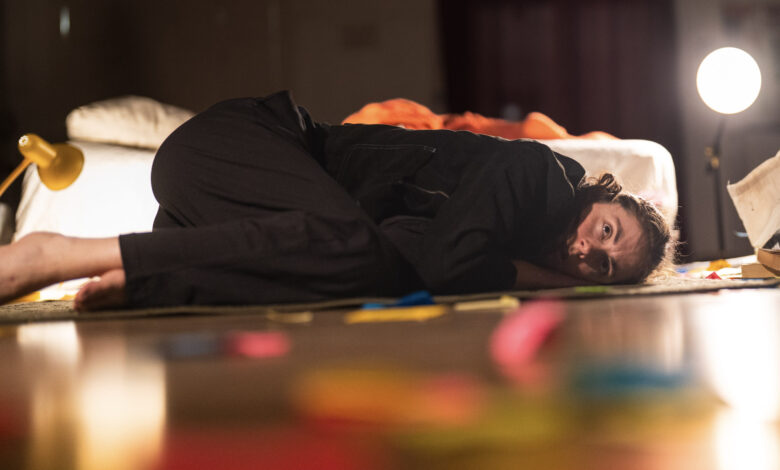Review: Instructions on How to Be Alone, Centre 151
Through a young person’s crisis, this show points out how our current systems fail to deliver critical mental health support with character and wicked irony - it just needs to breathe.Rating
OK
The Missing Theatre’s Instructions on How to Be Alone (IOHTBA), written and directed by Marguerite Vermersch, opens as a performance installation: a young woman (Maire McGovern) slumps over a single bed in a small room littered with colourful sticky notes, picking at her nails while automated hold music (Hélios Lyons) loops – a suicide crisis hotline keeping her waiting. The setup recalls Tracey Emin’s My Bed – that forensic documentation of depression’s violent debris and the romanticisation of a young person’s unravelling. As the cheerless tune fades, McGovern delivers her first line: ‘My day-to-day state is… an overwhelming state of overwhelmedness.’
McGovern traverses Tom McVeigh’s artfully messy set with childlike awkwardness – dashing, tip-toeing, tripping – creating moments of precariousness. The set design is casual but effective: a mirror crowned with self-help memos, an open laptop, discarded clothes draped over a chair. McGovern’s physical commitment to the character is admirable, though her navigation of the set feels somewhat careful, as if protecting the space rather than truly inhabiting it. There are hints of more – a flicker of joy when she briefly pretends to be a cat, satisfying thuds as she hurls clothes to the floor – suggesting the fuller chaos she could embrace.
Throughout the piece, McGovern’s character converses with the hotline’s automated voice (Scarlett Malone). There is some wicked irony through these interactions: impersonal self-care tips, dramatically downplayed concerns, bizarre meditations. When she responds verbally to screening questions rather than pressing buttons as instructed, slams her laptop shut to avoid a video call, or rotates the mirror away from the room, IOHTBA poses an interesting question: Does she actually want to get out, literally or figuratively?
It is hard not to think of the current discourse on the ‘loneliness epidemic’ exacerbated by the COVID-19 pandemic and social media. IOHTBA hints at something more universal – that loneliness is endemic to contemporary life and that the failures of our current systems make self-destruction easier than getting help. Yet the piece never quite commits to this deeper critique. It reads as a character study of a young person’s descent into madness (there are the stereotypical pills, obsessions with intruders, doubting reality) and a warning against the outsourcing of essential mental health care to ‘self-care.’
The persistent dialogue between the main character, hotline narrator, and a third (imaginary?) voice eclipses the installation-like qualities that make the opening so visually compelling. Two well-acted breakdowns break up the show’s pace, both resolving with McGovern’s character whispering consolingly to herself, but nothing changes. The circular ending (she pulls out another phone to call the same hotline) points to the systemic failures that trap all of us, but we are well aware of them. What else does IOHTBA want to tell us?
There’s a distinct interiority to the whole piece. Though we are in close quarters (sat in a horseshoe around the bedroom), the main character never acknowledges us – a shame, as it would give the audience a real stake in her crisis and force us to confront our role as bystanders (in theatre and life). Without bridging this gap, we can only consider her from an aesthetic distance as a curiosity of sorts, trapped within the theatre of her room. IOHTBA tackles vital themes about support systems and loneliness, and could lean more into embodied moments and a deeper investigation of its central character’s motivations. There’s a powerful message here – it just needs room to breathe.
Writer & Director: Marguerite Vermersch
Creative Producer: Esalan Gates
Composer & Sound Design: Hélios Lyons
Lighting & Set Design: Tom McVeigh
Dramaturgy: Jack Aldisert
Assistants: Kyndall Sillanpaa & Amber Williams
Instructions on How to Be Alone has completed its performance at Centre 151
but returns at London’s COLAB Tower, Wednesday, December 3.






